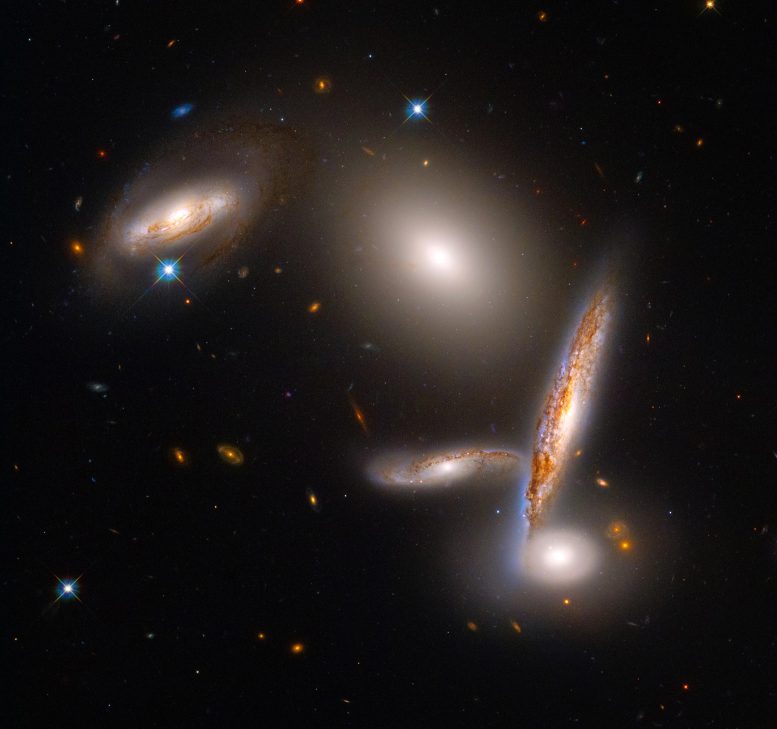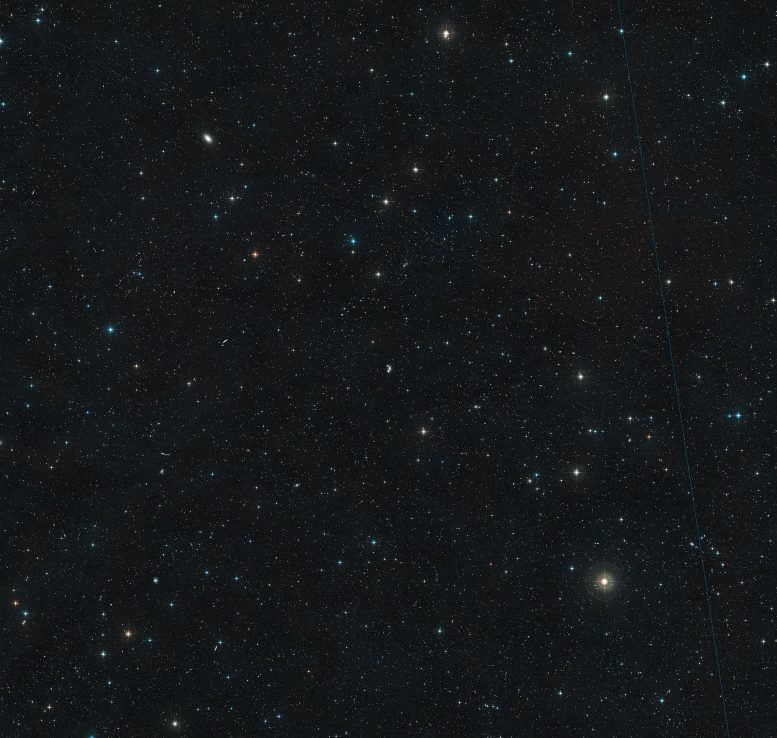
The NASA/ESA Hubble Space Telescope is celebrating its 32nd birthday with a stunning look at an unusual close-knit collection of five galaxies, called the Hickson Compact Group 40. This snapshot reflects a special moment in their lifetimes as they fall together before they merge. Credit: NASA, ESA and STScI
The NASA/ESA Hubble Space Telescope is celebrating its 32nd birthday with a magnificent view of the Hickson Compact Group 40, an extraordinary close-knit grouping of five galaxies. This photograph captures a special moment in their lifetimes as they fall together before merging.
This menagerie includes three spiral-shaped galaxies, an elliptical galaxy, and a lenticular (lens-like) galaxy. Somehow, these different galaxies have crossed paths to create an unusually crowded and diversified galaxy sampler.
The NASA/ESA Hubble Space Telescope is celebrating its 32nd birthday with a stunning look at an unusual close-knit collection of five galaxies.
Caught in a leisurely gravitational dance, the whole group is so closely packed that it could fit within a region of space that is less than twice the diameter of our Milky Way’s stellar disc.
Though such galaxy groupings can be found in the center of massive galaxy clusters, these galaxies are notable for being isolated in their own small area of the Universe, in the direction of the constellation Hydra.

This image shows a wide-field view centered on the Hickson Compact Group 40. Credit: ESA/Hubble, Digitized Sky Survey 2, Acknowledgment: D. De Martin
One possibility is that there’s a lot of dark matter (a poorly understood and invisible form of matter) associated with these galaxies. If they come close together the dark matter can form a big cloud within which the galaxies orbit. As the galaxies plow through the dark matter they feel a frictional force that results from its gravitational effects. This slows their motion and makes the galaxies lose energy, so they fall together. As a result, this photograph captures the galaxies at a particularly special point in their lives. They will eventually collide and combine to form a single gigantic elliptical galaxy in around 1 billion years.
The NASA/ESA Hubble Space Telescope is celebrating its 32nd birthday with a stunning look at an unusual close-knit collection of five galaxies, called the Hickson Compact Group 40. This snapshot reflects a special moment in their lifetimes as they fall together before they merge. Credit: NASA, ESA, and STScI
This compact galaxy group has been studied not only in visible light, but also in radio, infrared, and x-ray wavelengths. Almost all of the galaxies have a compact radio emission source at their core, which could indicate the presence of a supermassive black hole. X-ray observations reveal that the galaxies have been gravitationally interacting, as evidenced by the presence of a large amount of hot gas among them. Infrared observations reveal clues on the rate at which new stars develop.
Though over 100 such compact galaxy groups have been cataloged in sky surveys going back several decades, Hickson Compact Group 40 is one of the most densely packed. Observations suggest that such tight groups may have been more abundant in the early Universe and provided fuel for powering black holes, known as quasars, whose light from superheated inflating material blazed across space. Studying the details of galaxies in nearby groups like this helps astronomers sort out when and where galaxies assembled themselves, and what they are assembled from.
For more on this, see Celebrating Hubble’s 32nd Birthday: A Stunning Look at an Unusual Collection of Five Galaxies.
More information
The Hubble Space Telescope is a project of international cooperation between ESA and NASA.
As Hubble celebrates its 32nd year of operations, below are some captivating facts about the famous observatory’s achievements and impact:
- Launched on April 24, 1990, the NASA/ESA Hubble Space Telescope has made more than 1.5 million observations of about 50,000 celestial objects.
- Astronomers using Hubble data have published more than 19,000 scientific papers, with more than 1000 of those papers published in 2021.
- Approximately 100,000 citations attributed to Hubble are accumulated every three years. On average, each paper based on Hubble data has roughly 54 citations.
The observations were conducted as part of the Hubble observing program 16848 (PI: C. Britt).
https://news.google.com/__i/rss/rd/articles/CBMib2h0dHBzOi8vc2NpdGVjaGRhaWx5LmNvbS9jZWxlYnJhdGluZy10aGUtaHViYmxlLXNwYWNlLXRlbGVzY29wZXMtMzJuZC1iaXJ0aGRheS13aXRoLWEtc3R1bm5pbmctZ2FsYXh5LWdyb3VwaW5nL9IBc2h0dHBzOi8vc2NpdGVjaGRhaWx5LmNvbS9jZWxlYnJhdGluZy10aGUtaHViYmxlLXNwYWNlLXRlbGVzY29wZXMtMzJuZC1iaXJ0aGRheS13aXRoLWEtc3R1bm5pbmctZ2FsYXh5LWdyb3VwaW5nL2FtcC8?oc=5
2022-04-23 21:18:56Z
1391690346
Tidak ada komentar:
Posting Komentar